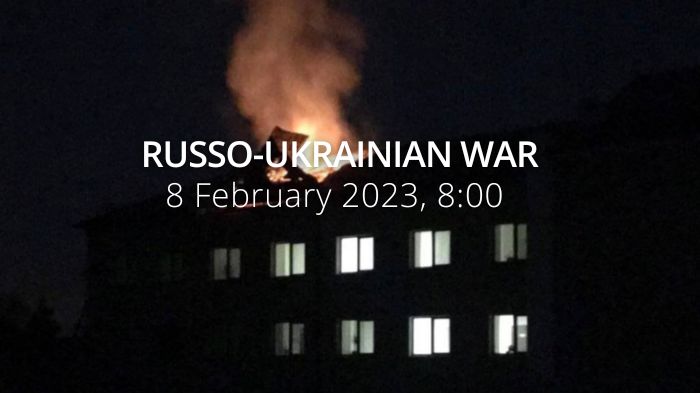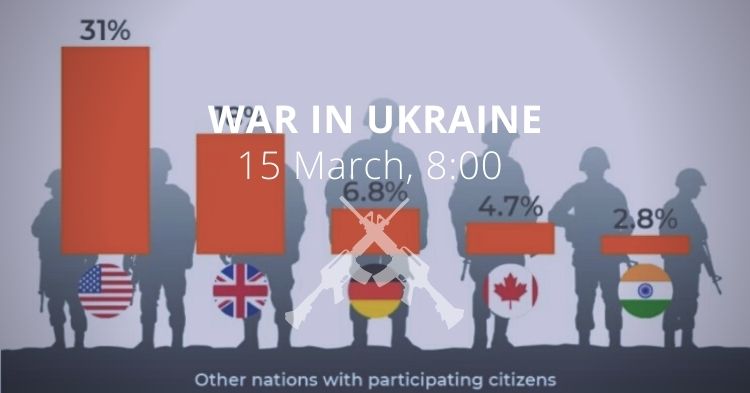Daily overview — Summary report, December 24
A map of the approximate situation on the ground in Ukraine as of 00:00 UTC 24/12/22.
— War Mapper (@War_Mapper) December 24, 2022
It has now been 10 months since Russia's escalation through an invasion across the length of its border with Ukraine.
There have been no notable changes to control since the last update. pic.twitter.com/00dBZ5yE2W
The General Staff’s operational update regarding the Russian invasion as of 18.00 pm, December 24, 2022 is in the dropdown menu below:
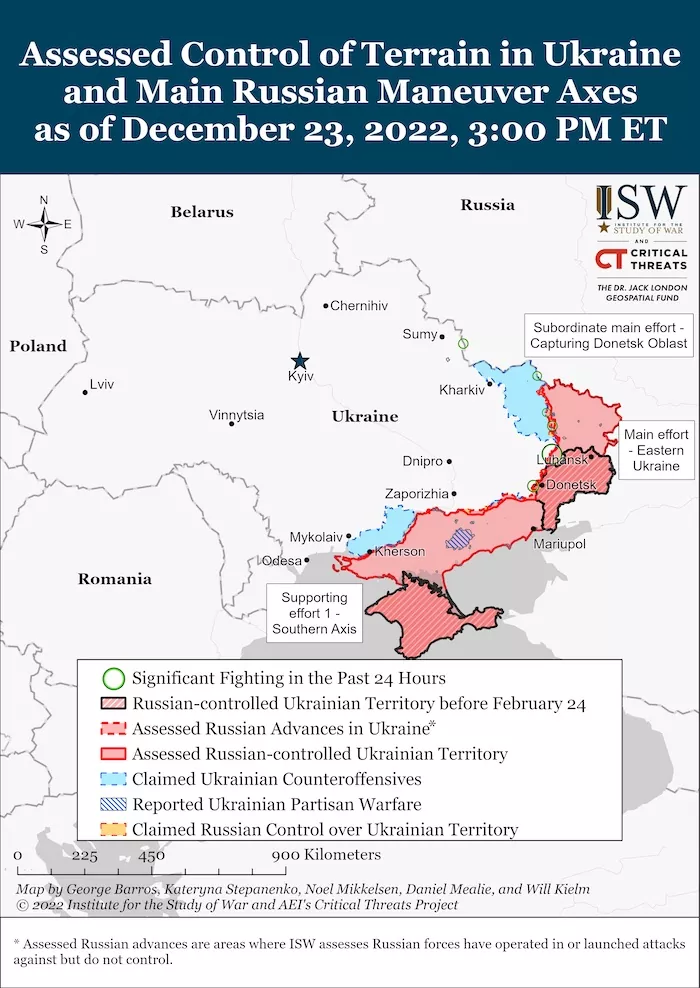
- In the Siverskyi direction, Russian forces shelled the area of the village of Hirka, Sumy region, with mortars.
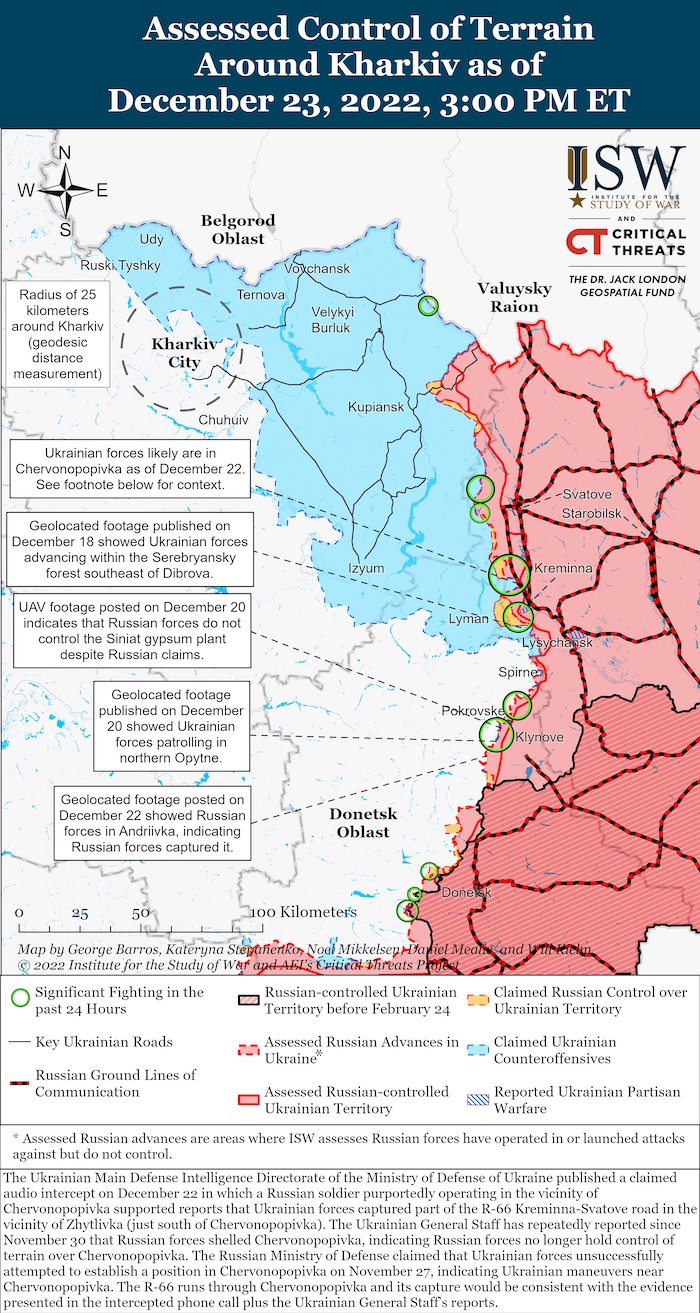
- In the Slobozhanskyi direction, areas of the settlements of Guryiv, Veterinarne, Kudiivka, Hoptivka, Staritsa, Ogirtseve, Vovchansk, Ambarne, Novomlynsk and Dvorichna in Kharkiv region were hit by mortar and artillery fire.
- In the Kupiansk direction, Russian forces fired tanks, mortars and artillery in the areas of Kislivka, Kotlyarivka, Tabaivka, Krokhmalny of Kharkiv region and Novoselivka, Stelmakhivka and Myasozharivka of Luhansk region.
- In the Lyman direction, Makiyivka, Ploschanka, Chervonopivka, Terny and Dibrova in the Luhansk region came under fire.
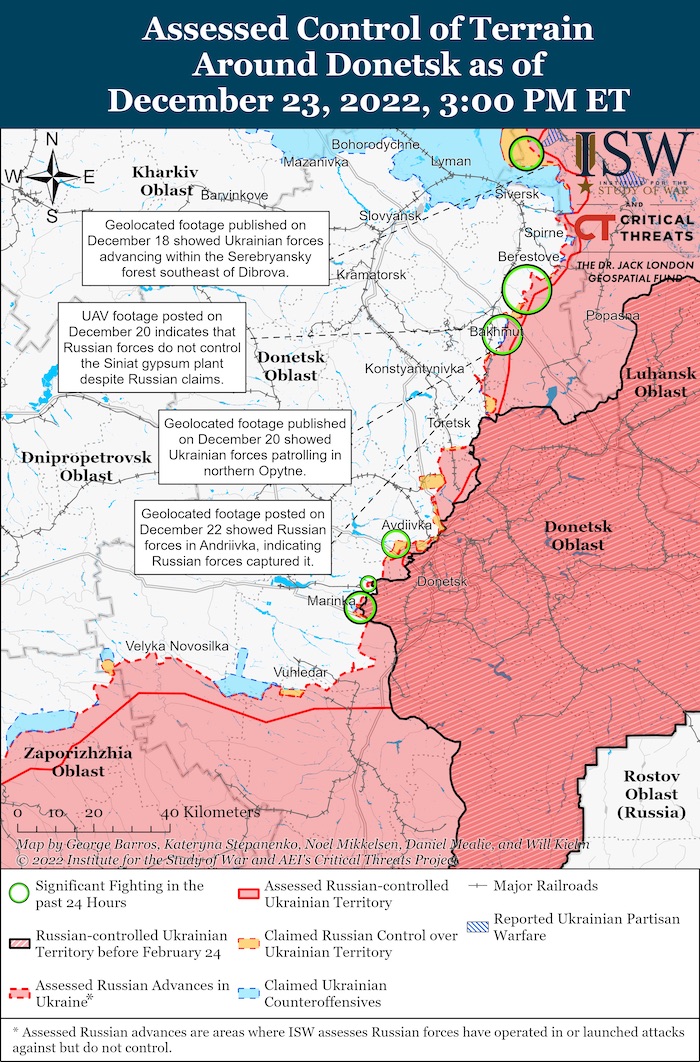
- In the Bakhmut direction, Russian forces shelled the areas of twenty-five settlements with tanks, mortars, artillery and MLRS. Among them are Spirne, Berestov, Soledar, Bakhmut, Klishchiivka, Chasiv Yar, Stupochki, Bila Gora, Diliivka and Opytne of the Donetsk region.
- In the Avdiivka direction, shelling was recorded near Kamianka, Avdiivka, Vesely, Vodyanyi, Pervomaiskyi, Nevelskyi, Krasnohorivka, Georgiivka, Mariinka, and Novomykhailivka in the Donetsk region. Russian forces also carried out an airstrike near Avdiivka.
- In the Novopavlivsk direction, Vugledar, Prechistivka and Velyka Novosilka in Donetsk region came under artillery fire.
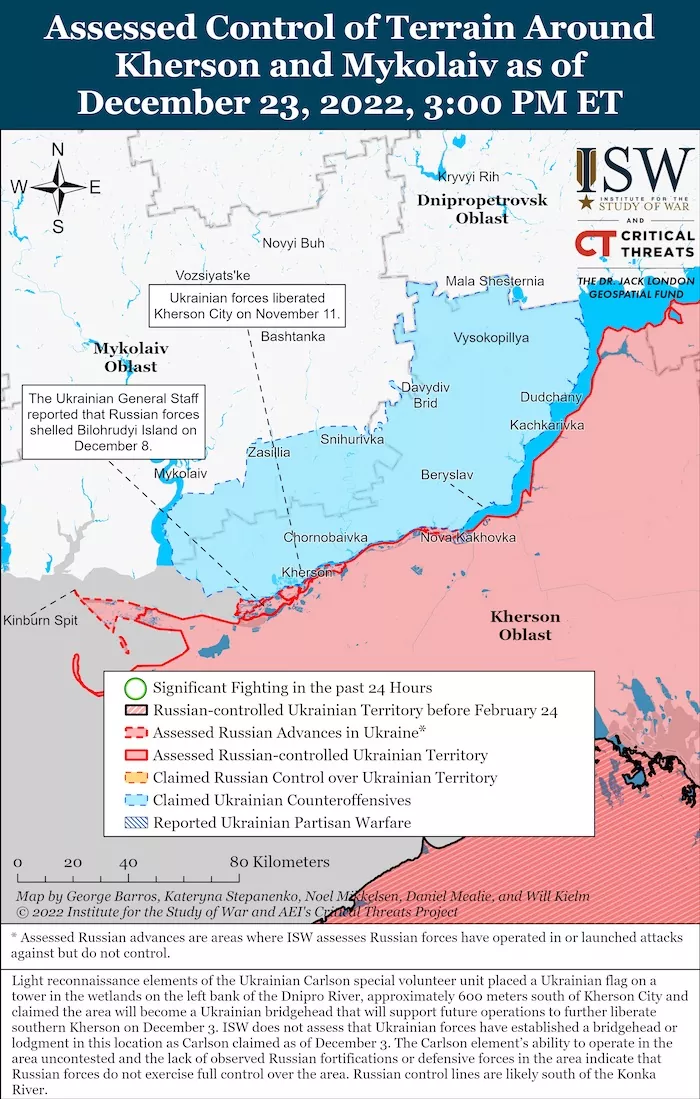
- In the Zaporizhzhia and Kherson directions, more than fifty settlements were shelled by rocket and barrel artillery. Among them are Vremivka, Malynyvka, Dorozhnyanka, Mala Tokmachka in the Zaporizhzhia region and Kherson, Havrylivka, Novodmytrivka, Burgunka, Inzhenerne and Chornobiivka in the Kherson region.
Military Updates
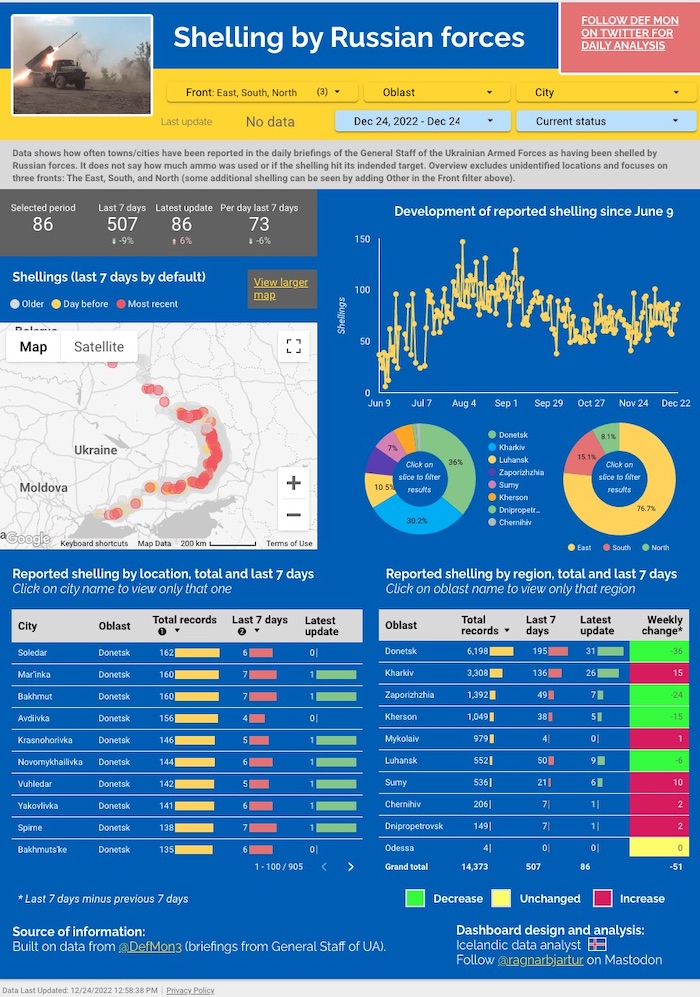
According to British Defence Intelligence, (last 48 hours):Sudden increase in Russian navy activity in Black Sea on Dec 22 may indicate impending military operation - NavalNewshttps://t.co/31RbIiqAvI
— Euromaidan Press (@EuromaidanPress) December 23, 2022
- Russia has augmented its force in Ukraine with tens of thousands of reservists since October. Despite the easing of its immediate personnel shortages, a shortage of munitions highly likely remains the key limiting factor on Russian offensive operations.
- Russia has likely limited its long-range missile strikes against Ukrainian infrastructure to around once a week due to the limited availability of cruise missiles. Similarly, Russia is unlikely to have increased its stockpile of artillery munitions enough to enable large-scale offensive operations.
- A vulnerability of Russia’s current operational design is that even just sustaining defensive operations along its lengthy front line requires a significant daily expenditure of shells and rockets
- On 21 December, President Putin was presented with plans to expand the Russian military by around 30% to 1.5 million personnel. It isn’t clear when this level would be achieved.
- Russian Defence Minister Sergei Shigou explained that the expansion would involve at least two brigades in north-western Russia growing to divisional strength. He cited the supposed threat from Finland and Sweden’s accession to NATO.
- This constitutes one of the first insights into how Russia aspires to adapt its forces to the long-term strategic challenges resulting from its invasion of Ukraine. It remains unclear how Russia will find the recruits to complete such an expansion at a time when its forces are under unprecedented pressure in Ukraine.
Losses of the Russian army
As of Saturday 24 December, the approximate losses of weapons and military equipment of the Russian Armed Forces from the beginning of the invasion to the present day:- Personnel – about 101430 (+480),
- Tanks – 3006 (+1),
- Armoured combat vehicles – 5994 (+8),
- Artillery systems – 1988 (+4),
- Multiple rocket launchers –MLRS - 418 (+4),
- Air defence means – 212 (+0),
- Aircraft - 283 (+0),
- Helicopters - 267 (+0),
- Automotive technology and fuel tanks – 4627 (+5),
- Vessels/boats - 16 (+0),
- UAV operational and tactical level – 1706 (+8),
- Special equipment – 178 (+0),
- Mobile SRBM system – 4 (+0),
- Cruise missiles – 653 (+0)
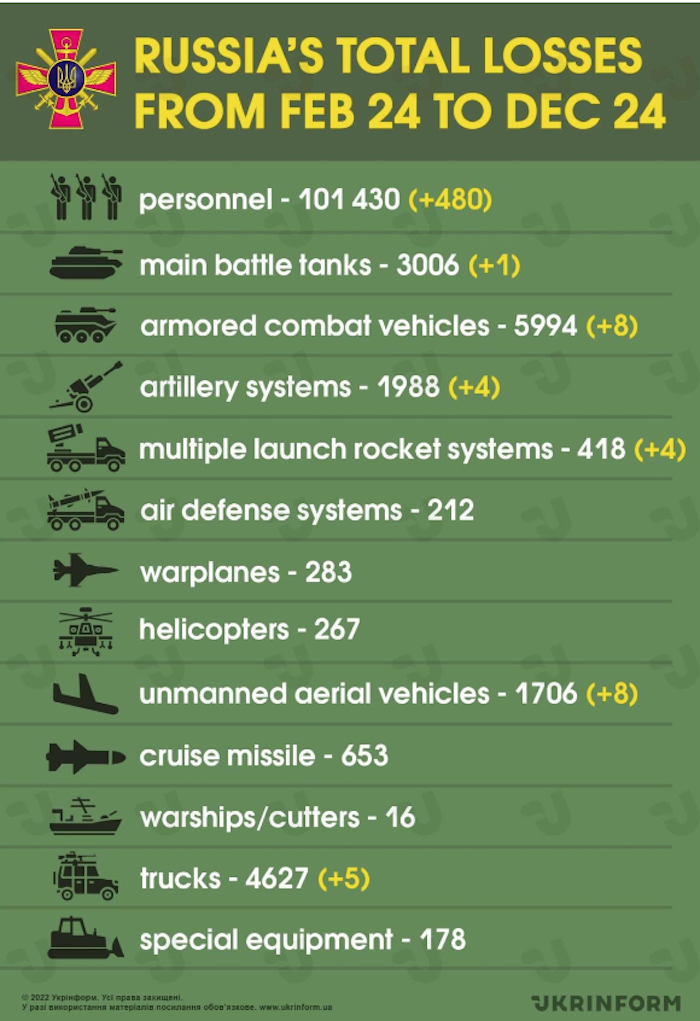
Humanitarian
https://twitter.com/EuromaidanPress/status/1606399850953703425 Lies and missiles continue to terrorise Ukrainian civilians, EUvsDisinfo reports. “Russia continues to terrorise Ukraine’s civilian population with missile attacks against civilian infrastructure to make lives intolerable during the harsh winter months and to force them to leave their homes. At the same time, the pro-Kremlin disinformation ecosystem is proactively targeting possible recipient countries of additional Ukrainian refugees in the West as well as in Central Asia. The disinformation bombardment includes narratives claiming that Ukrainians are not welcome or that those already residing in these countries should leave. The manipulated information includes false YouTube advertisements and altered pictures of graffiti in major European urban areas (see the earlier Myth Detector’s debunk). The intent is to create a false impression that locals in recipient countries are calling for Ukrainians to leave or that they see support for Ukraine as a burden. Lies like these attempt to stoke fear and intolerance toward Ukrainians in targeted countries across Europe. They also try to erode popular support for Ukraine in the West, which is necessary to back up governments’ military and financial assistance to Ukraine. Moreover, Kremlin propagandists want to persuade Ukrainians that Western support for them is waning. These narratives are a part of cynical and sinister Kremlin campaign to harm Ukrainians physically and mentally – physically through destroying homes and infrastructure for electricity, heat, and water, and mentally through smashing Ukrainian hopes and resilience. It is disinformation woven into the fabric of psychological warfare. Total war per the modern Kremlin playbook.” [EUvsDisinfo is the flagship project of the European External Action Service’s East StratCom Task Force. It was established in 2015 to better forecast, address, and respond to the Russian Federation’s ongoing disinformation campaigns affecting the European Union, its Member States, and countries in the shared neighbourhood. As of today, the database contains 14,749 disinformation cases, many of which, unfortunately, are too often retold by Western media.] Millions of refugees from Ukraine have crossed borders into neighbouring countries, and many more have been forced to move inside the country. The escalation of conflict in Ukraine has caused civilian casualties and destruction of civilian infrastructure, forcing people to flee their homes seeking safety, protection and assistance the UNHCR reports. As of 20 December:| Individual refugees from Ukraine recorded across Europe: | 7,863,339 |
| Bulgaria, Czech Republic, Hungary, Poland, Republic of Moldova, Romania, Slovakia | 2,407,368 |
| Other European countries | 2,585,789 |
| Russian Federation, Belarus | 2,870,182 |
| Refugees from Ukraine registered for Temporary Protection or similar national protection schemes in Europe: | 4,862,561 |
| Bulgaria, Czech Republic, Hungary, Poland, Republic of Moldova, Romania, Slovakia | 2,398,959 |
| Other European countries | 2,463,602 |
| Border crossings from Ukraine (since 24 February 2022): | 16,595,007 |
| Border crossings to Ukraine (since 28 February 2022): | 8,711,402 |
Environmental
The Russian-installed official in Ukraine's Zaporizhzhia region says the shelling of the nuclear plant has almost stopped, Reuters reports. “The top Russian-installed official in Ukraine's Zaporizhzhia region said on Friday that shelling of the Russian-controlled nuclear power plant there had "almost stopped". Speaking on Russian state television, Russian-installed regional governor Yevgeny Balitsky said that Russian troops would not leave the nuclear power station and that it would never return to Ukrainian control. The Zaporizhzhia plant, Europe's largest, was captured by Russian forces in March, soon after their invasion of Ukraine. The plant remains near the frontlines and has repeatedly come under fire in recent months, raising fears of a nuclear disaster. Moscow and Kyiv have accused each other of shelling the facility. The International Atomic Energy Agency is attempting to broker an agreement around the plant's security, proposing to create a safe zone around it. Russian officials on Thursday heralded progress in talks with IAEA chief Rafael Grossi in Moscow.”Legal
Russia begins demolition of bombed Mariupol theatre, Reuters reports. Russian authorities in the occupied Ukrainian city of Mariupol have begun demolishing most of the city's drama theatre, where Ukrainian authorities say hundreds died in an air bombardment in March. Ukrainian officials denounced the demolition as a bid to cover up the deaths in the March 16 bombardment and wipe out Ukrainian culture. AP evidence points to 600 dead in the Mariupol theatre airstrike. An Associated Press investigation in May found evidence that the attack was “far deadlier than estimated, killing closer to 600 people inside and outside the building. That’s almost double the death toll cited so far, and many survivors put the number even higher.” Senate backs plan to use money from seized Russian assets to aid Ukraine, The Washington Post reports. “The Senate unanimously backed a plan to use certain confiscated Russian assets to aid Ukraine in its war with Russia. The United States and other countries targeted Russia and its oligarchs with a host of diplomatic and economic sanctions as punishment after it invaded its neighboring country in February. But US law limited how money from those assets could be used, according to lawmakers. […] President Biden supported using proceeds from seized Russian assets to help Ukraine and is expected to sign the spending package into law. The Senate’s action comes one day after Biden, joined by Ukrainian President Volodymyr Zelensky at the White House, announced a new $1.85 billion security assistance package for Ukraine. […] Rep Tom Malinowski (D-N.J.), who sponsored the effort in the House, said it makes sense to use assets from friends of Russian President Vladimir Putin to rebuild Ukraine. It’s what common sense and justice demand — making Putin’s enablers pay to help rebuild the country he’s destroying, Malinowski told The Washington Post. I hope the law encourages the Justice Department to redouble its kleptocrat asset seizure efforts, and our European allies to follow suit.”#Belarus #rail_partisan sentenced to 16 years for obstructing #Russia invasion of #Ukraine #Vitaliy+Melnik #StandWithUkraine #RussiaWarCrimes #StopRussia #Lukashenkahttps://t.co/keIrzPBeTH pic.twitter.com/QdTfSM3gSf
— Halya Coynash (@halyapuff) December 23, 2022
Ukraine's parallel war on corruption to unlock door to West, Reuters reports. “To an outsider, it may seem an unlikely time for Ukraine to double down on the battle against corruption, as missiles rain down on cities and citizens fight for their lives. […] Every week, there are one or two big developments plus seven or eight smaller ones that are still important, said legal expert Vadym Valko, who monitors the work of anti-corruption authorities in Ukraine, which is fighting to rid itself of oligarchs and strengthen its vulnerable institutions. […] The drive is deemed urgent enough for the government to devote resources to, even during Russia's invasion. Indeed, anti-corruption agencies flag their work almost daily in a flurry of statements and social media posts. In November alone, they reported having launched investigations into 44 new criminal cases, issued 17 notices of suspicion to people being investigated and sent six indictments to court. In 2022, prosecutors have filed at least 109 indictments in 42 cases, the Specialized Anti-Corruption Prosecutor's Office (SAPO) told Reuters, adding that 25 convictions had been handed down. The work can't wait, according to the people interviewed, because curbing endemic corruption is key to reassuring Western partners preparing to send tens of billions of dollars of aid that will be needed to rebuild the country in coming years. It would also be crucial, they say, to winning a status that guarantees Ukraine's long-term security from any future aggression: membership of the European Union, which says getting on top of graft is a must for candidacy talks to begin. It's extraordinarily important right now for Ukraine to demonstrate itself as a predictable partner, said Yaroslav Yurchyshyn, first deputy head of the parliamentary committee on anti-corruption policy, referring to Western donors. In reality, there are two wars going on in Ukraine at once: an open one with Russia, and another with the post-Soviet corrupt past that's happening within.” 450 children were killed, 868 children injured, 13,613 deported by foe forces, and 331 reported missing - the Office of the Prosecutor General of Ukraine reports as of December 24. 3,126 educational establishments are damaged as a result of shelling and bombings, 337 of them are destroyed fully.Brutal torment of young #Mariupol woman imprisoned at #Olenivka ‘concentration camp’ and in #Russia #Ukraine #Checheliuk #LetMyPeopleGo #StandWithUkraine #RussiaWarCrimes #StopRussia https://t.co/CGtVk77hYY pic.twitter.com/oXss2P0uJO
— Halya Coynash (@halyapuff) December 23, 2022
Support
https://twitter.com/EuromaidanPress/status/1606378410019762176 US aid to Ukraine an ‘investment’ in global security, Zelenskyy says, Military Times reports. “Ukrainian President Volodymyr Zelenskyy said Wednesday that against all odds Ukraine still stands, as he paid a defiant wartime visit to Washington to thank US leaders and ordinary Americans for their support in fighting off Russia’s invasion. He pledged there would be no compromises in trying to bring an end to the war. Delivering an impassioned address to Congress aimed at sustaining support for his country’s defense, Zelenskyy called the tens of billions of dollars in US military and economic assistance over the past year vital to Ukraine’s efforts to beat back Russia and appealed for even more in the future. Your money is not charity, he sought to reassure both those in the room and those watching at home. It’s an investment in the global security and democracy that we handled in the most responsible way.” https://twitter.com/EuromaidanPress/status/1606333818515984385 US spent 5% of its military budget to destroy half of Russia’s capability with the help of Ukraine — CEPA, Euromaidan Press reports. “The new analysis of The Center for European Policy Analysis (CEPA) by Timothy Ash proves the US support for Ukraine is extremely cost-effective. Spending relatively tiny amount of money, the US helped to destroy already half of Russian’s military capability. US spending of 5.6% of its defense budget to destroy nearly half of Russia’s conventional military capability seems like an absolutely incredible investment,” the analysis reads. Altogether, the Biden administration received Congressional approval for $40bn in aid for Ukraine for 2022 and has requested an additional $37.7bn for 2022. More than half of this aid has been earmarked for defense. These sums pale into insignificance when set against a total US defense budget of $715bn for 2022.” The Netherlands earmarks €2.5 billion for support to Ukraine in 2023, The Government of the Netherlands wrote in a statement. “In the coming year Ukraine will continue to need considerable international support. Russia’s war in Ukraine is still ongoing, and has turned into a war of attrition. Ukraine’s armed forces continue fighting every day for the freedom, security and prosperity of their country, and thus for that of Europe as a whole. The Dutch government’s decision to earmark funding now sends a clear message of undiminished solidarity with the people of Ukraine, who can count on predictable Dutch support for as long as it takes. Military aid will be drawn from the Netherlands’ own stocks and purchased from commercial suppliers. The Netherlands is committed to coordinating and collaborating with other countries and the defence industry. This should enhance the effectiveness of arms shipments for Ukraine's armed forces while limiting the impact on our own. The aid for essential reconstruction activities is intended for infrastructure repairs (especially energy infrastructure), hospitals, housing, agriculture and demining. The government is also providing humanitarian aid and support for the rule of law, human rights and accountability. The amount set aside for Ukraine is on top of the liquidity support totalling €18 billion being channelled via the EU and the cost of refugee reception in the Netherlands.” Denmark allocates funds to purchase weapons for Ukraine, Mil.in.ua reports, citing the Ministry of Defense of Denmark. “The Danish government and parliament made a decision to allocate funds to purchase additional weapons for Ukraine. Denmark will allocate 300 million DKK, which is equal to approximately $43 million. “Ukraine’s struggle for freedom is also ours. That is why the government, together with the parties in the parliament, decided to allocate another 300 million DKK to Ukraine. The government will continue providing financial, military, and humanitarian assistance to Ukrainians,” Danish Defense Minister Jakob Ellemann-Jensen emphasized. These funds will be provided from the country’s Ministry of Defense budget and will be transferred to the British-led International Fund for Ukraine.” UK to give Ukraine $500M through World Bank project, Ukrinform reports, citing the Ukrainian Finance Ministry's press service. “The United Kingdom will provide Ukraine with $500 million through a World Bank project to pay social assistance to families with children and pay salaries to employees of state-owned higher education institutions.”British Prime Minister published a moving video in support of Ukraine https://t.co/4ytpEA3vNN
— Euromaidan Press (@EuromaidanPress) December 23, 2022
New Developments
- Zelenskyy's team to present peace formula in February, Ukrainska Pravda reports, citing The Wall Street Journal. “According to the WSJ, Zelenskyy’s team is currently fleshing out the plan. They aim to present their ideas on or around the first anniversary of Russia’s 24 February invasion, according to European and Ukrainian diplomats. […]Kyiv wants to prepare for potential peace talks by achieving military victories. President Volodymyr Zelenskyy has discussedthe Ukrainian peace formula with his US counterpart Joe Biden, and the American leader supported the idea of holding a peace summit.”
- Kremlin explains Putin's words about imminent end of war, Ukrainska Pravda “On 22 December, Vladimir Putin, the President of the aggressor country, stated that Russia allegedly wants to end the warin Ukraine as soon as possible, but wants to avoid great losses. "There are no previous contacts regarding it [negotiations - ed.]. Of course, any conflict ends at the negotiating table. It is primarily about ending the special military operation [the official term used by Russians to describe the ongoing war with Ukraine – ed.] as soon as possible by achieving the goals that the Russian Federation sets for itself", Dmirty Perskov, Press Secretary of the President of the Russian Federation said].”
- Putin tells Russian defence industry to up its game for Ukraine war, Reuters “President Vladimir Putin on Friday told Russia's defence industry chiefs to up their game to ensure that the Russian army quickly got all the weapons, equipment and military hardware it needed to fight in Ukraine. Putin, who has cast Russia's war in Ukraine as part of an historic effort to push back against what he says is excessive Western influence over global affairs, made the comments during a visit to Tula, a centre for arms manufacturing.”
- Charles Michel supports suspension of Russia's membership in UNSC, Ukrinform “President of the European Council, Charles Michel, advocates the development of a mechanism that would lead to having Russia's membership in the UN Security Council suspended over its aggression against Ukraine.”
- Kremlin believes that Russia "substantially demilitarised" Ukraine, Ukrainska Pravda reports, citing RIA Novosti, quoting Dmirty Perskov, Press Secretary of the President of the Russian Federation. “The Russian authorities believe that they have already "significantly advanced" on the path of demilitarisation, which they called one of the goals of the war against Ukraine.”
- G7 to support Ukraine for as long as it takes – statement, Ukrinform “The G7 countries have pledged to continue to support Ukraine, strengthen sanctions against Russia and, if necessary, against Belarus, as well as work to bring Russian criminals to justice. G7 members recalled that indiscriminate attacks, as well as attacks on the civilian population or civilian objects constitute a war crime," according to a statement posted on the website of the German Foreign Ministry, which chaired the group in 2022. The statement also contains a warning to Minsk: "Any further active participation in the Russian illegal war of aggression would run counter to the will and aspirations of the Belarusian people. If the Belarusian authorities more directly involve Belarus in Russia's war, the G7 will impose overwhelming additional costs on the regime."
- Russia says it may cut oil output up to 7% over price cap, Reuters “Russia may cut oil output by 5%-7% in early 2023, as it responds to price caps on its crude and refined products, and halt sales to the countries that support them, Deputy Prime Minister Alexander Novak told state television on Friday. Detailing for the first time the Russian response to the price caps introduced by the West over Moscow's invasion of Ukraine, Novak said the cuts could reach 500,000-700,000 barrels per day (bpd).”
- Germany arrests intelligence service employee suspected of spying for Russia, Reuters “German authorities said on Thursday they had arrested an employee of its foreign intelligence service (BND) on suspicion of sharing state secrets with Russia this year and thereby committing treason.”
- IMF believes Russia loses European gas market for good, Ukrinform “Russia has lost what was left of access to the European gas market because Europe finally understood that Russian gas is a tool of war rather than an economic one. That’s according to Alternative Executive Director at the International Monetary Fund (IMF), Vladyslav Rashkovan. He recalled that Ukraine had since 2014 warned European partners that this is a weapon, not an economic tool. Rashkovan also emphasized that the sanctions imposed on Russian Federation are effective, and that in the long term, Russia has no economic prospects.”
Assessment
- On the war.
The Institute for the Study of War has made the following assessment as of December 23, 2022:
- ISW assesses that the Kremlin has been setting conditions for a new most dangerous course of action (MDCOA)—a renewed offensive from Belarus possibly aimed at Kyiv—since at least October 2022. The Kremlin may be conducting an information operation or may actually be preparing for this MDCOA, which ISW continues to assess to be unlikely but possible.
- Prominent Russian pro-war milbloggers are amplifying the possibility of the MDCOA over the winter-spring period.
- The Russian military continues to trip indicators for the MCDOA, reinforcing an information operation designed to establish the plausibility of the MDCOA or preparations to execute it.
- The Russian military has more clearly been setting conditions for an offensive in northwestern Luhansk Oblast.
- Ukrainian President Volodymyr Zelensky is reportedly preparing to present a peace plan in February 2023, which could be timed to exploit a failed Russian winter offensive.
- Russian President Vladimir Putin’s renewed public appearances likely indicate that he has become more concerned about his popularity and image in Russia.
- Russian forces conducted at least two reconnaissance-in-force operations in northern and northeastern Ukraine on December 22-23.
- Ukrainian forces likely made tactical gains east and south of Bakhmut City over the past 72 hours.
- Russian forces are continuing to establish defensive positions in left-bank Kherson and Zaporizhzhia oblasts and are conducting defensive operations in southern Ukraine.
- The Kremlin is intensifying its censorship efforts to silence concerns over an expansion of the Russian Armed Forces and a second mobilization wave.
- Consequences and what to do?
- To start negotiations on Ukraine's EU accession.
- Prepare for the planned NATO summit and ensure specific results of this summit for Ukraine.
- Updated defence and security needs.
- Restoration of the Ukrainian energy system and the implementation of the Fast Recovery Plan.
- New sanction packages against Russia.
- Work on the tribunal regarding the crime of aggression and the responsibility of war criminals.
- Find and freeze the assets of Russia and persons associated with the terrorist state on the territory of the host countries.
- "Supporting our people not just as much as you can, but much more."


